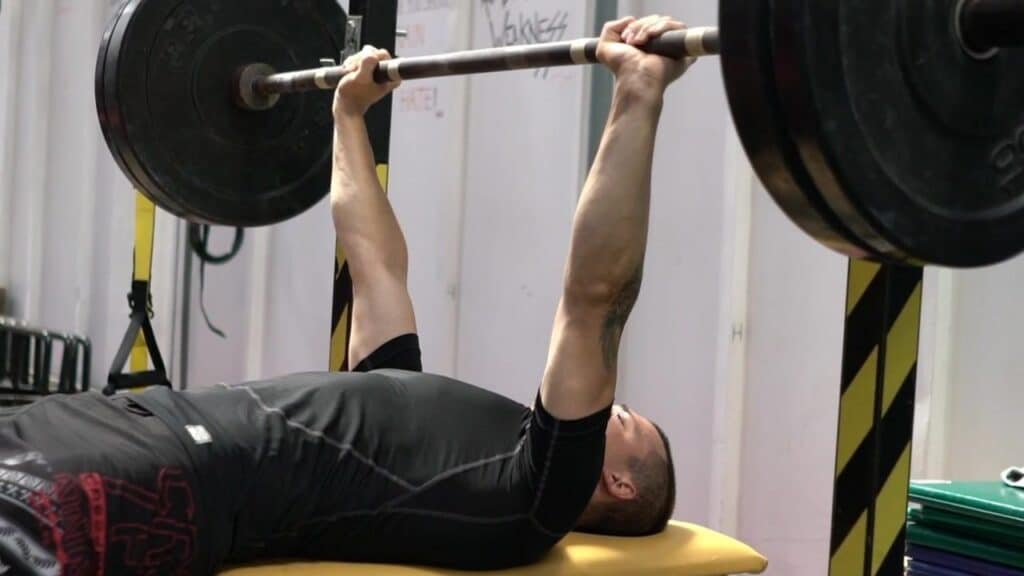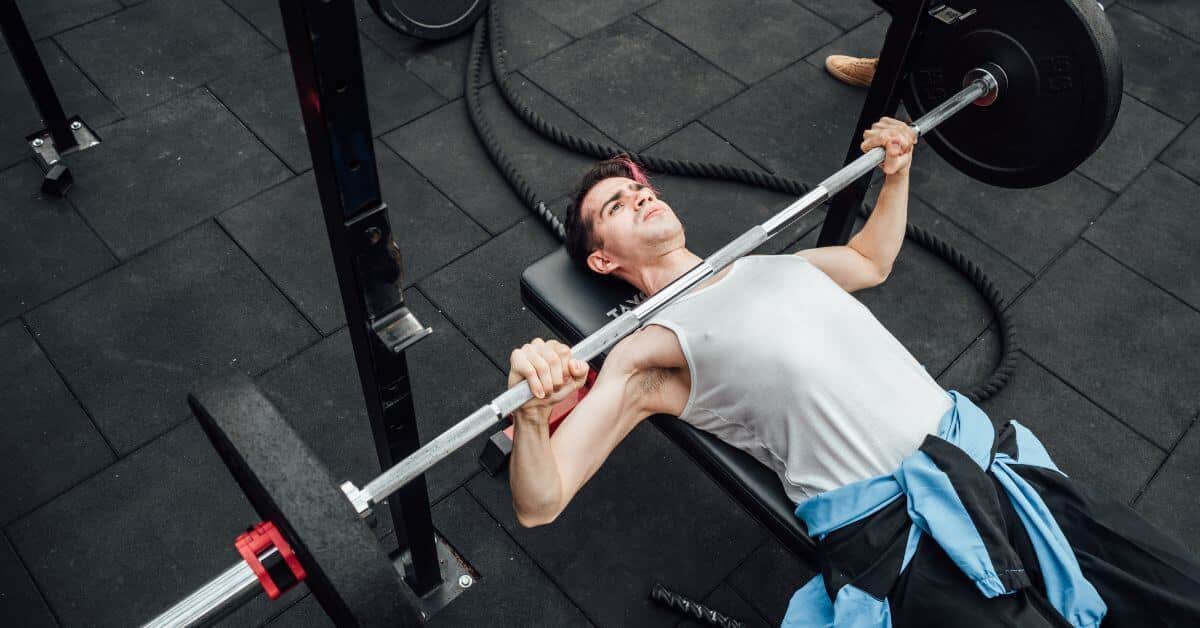Making your upper-body more functional is easy if you start implementing compound exercises into your workout routine. However, there is a big chance you get confused with the term compound and what it actually means. Is bench press a compound exercise?
Table of Contents
ToggleThe bench press is a compound exercise that builds upper body strength and follows the pushing movement pattern. All bench press variations are considered compound exercises since they work multiple muscles, such as the pectoral and triceps, which are excellent for developing horizontal upper body strength.
There are many benefits tied to bench pressing. However, certain bench press variations are better for developing a more functional body and should be incorporated into your fitness workout accordingly.
Start Building Your Dream Body Today
Ready to elevate your fitness game without falling into the trap of dull, repetitive routines that just don’t deliver? Imagine sculpting your ideal physique and boosting your health, all while still enjoying life’s pleasures, like those irresistible weekend getaways and your aunt’s legendary cheesecake. With our online fitness and nutrition coaching service, you don’t have to compromise. Dive into a personalized fitness journey that blends perfectly with your lifestyle, not against it. Book your completely free discovery consultation today, and take the first step towards a transformation that doesn’t require giving up the joys of life.

“I was skeptical about online fitness coaching, but Functional Body Savage completely changed my perspective. Vanja and Radomir’s personalized approach and attention to detail have helped me achieve goals I never thought possible. I’m stronger, more confident, and grateful for their guidance.”
Emily Thompson, San Francisco, CA
Learn More About Our Online Coaching ServiceQuick Summary
- The bench press is a compound exercise designed to build upper body pushing strength.
- Bench press alternatives include incline, decline, and narrow bench presses.
- Always aim to place your bench press at the beginning of the workout or after adequate rest to avoid getting injured.
What Is a Bench Press?
The bench press is an upper-body strength exercise performed lying on the bench, usually with a barbell. The bench press follows horizontal push movement patterns and can be performed with free weights and machines.
The classical bench press, or traditional bench press, refers to the position where the trainee is lying on the bench and performing horizontal pressing with the barbell in his hands.
To perform the bench press, you need some weight, which can be a barbell, dumbbell, or anything similar, and a bench where you will be lying down while performing the exercise. Bench press belongs to one big lift family, alongside compound exercises such as the squat and a deadlift.
What Muscles Does the Bench Press Work?
The muscles that the bench press works are the pectoralis major, anterior deltoid, triceps brachii, and serratus anterior. All these muscles work together synergistically to complete the bench press’s eccentric and concentric phases.
Prime movers responsible for the majority of force produced to complete the bench press are the pectoralis major, deltoid, and triceps brachii.
The wider the grip, the more the pectoral muscle works. Respectively, the narrower the grip, the more the triceps brachii will work to produce the necessary force.
If we look biomechanically, the pectoralis major is responsible for the adduction of the shoulder, and that’s why wider grips work the pectoral muscle more.
On the contrary, triceps brachii is responsible for extending the shoulder, which is closely replicated when bench pressing with a narrower grip.
How to Do a Bench Press?
To do a bench press, you will need a barbell and a flat bench. Lie on your back on a flat bench, take a shoulder-wide grip, keep your core engaged, lift the bar off the rack and then lower and press the bar accordingly.

Here is a step-by-step guide to performing a flat bench press:
- Lie on your back on a flat bench, grip the barbell shoulder-width apart, and place the bar directly over the shoulders.
- Keep your hips on the bench while pressing your feet firmly into the ground.
- Keep the neutral spine position and engage your core to avoid arching the back.
- Lift the bar off the rack
- Lower the bar to the chest level and then start pressing your feet into the floor as you push the bar back into the starting position.
Bench Press Variations
Bench press variations include traditional flat bench press, narrow grip bench press, incline bench press, and decline bench press. These basic bench press variations aim to target all pectoral muscle fibers.
However, there are plenty of more bench press variations, including:
- wide grip barbell bench press
- glute bridge dumbbell bench press
- alternating dumbbell bench press
- one and one quarter incline barbell bench press
- top-down alternating incline dumbbell bench press
- dumbbell neutral grip bench press
- incline dumbbell crush press
To make your own bench press variations, you should keep in mind four things:
- The equipment you are using – includes barbells, dumbbells, kettlebells, and so on.
- The starting position – includes lying on the bench, or floor, being in the glute bridge position, or similar.
- The number of limbs – alternative between bilateral and unilateral variations.
- Adapt muscle phases – change the range of motion in the eccentric and concentric phases.
For example, you can substitute a dumbbell bench press with a one-arm lying dumbbell bench press to add variety to your workouts and make them more functional.
Read our guide on the best functional chest exercises to build a bigger, stronger, and more functional chest.
Benefits of Bench Presses
Bench press has numerous benefits, one of which is building upper body strength. The bench press is a compound exercise that builds upper body strength in the horizontal pushing movement pattern.
The bench press can be used to build upper body strength, endurance, and power. Building a stronger upper body can improve your posture and make your day-to-day life easier in numerous different ways.
Combining bilateral and unilateral bench press variations can yield even more benefits. One of them is building more efficient stabilizers or muscles that are responsible for keeping the joint cartilage stable during the movement or a specific exercise.
Building stronger and more efficient stabilizers can reduce the risk of injury and prolong a professional sports career if you happen to be a professional athlete.
In addition, the bench press can be used as a corrective exercise to treat spine disorders like flatback syndrome.
“The bench press, the squat, and the deadlift are fantastic exercises. Between them, they cover a wide variety of movements and bodyparts. They also allow us to move huge amounts of weight, which in turn make them perfect for building lots of strength.” – Adam Sinicki, AKA The Bioneer, author of the Functional Fitness and Beyond
Is the Bench Press a Good Way to Build Muscle?
Yes, the bench press is a good way to build muscle. The bench press will build upper body muscles such as the pectoralis major, triceps brachii, and front delts.
Incorporating progressive overload into bench press training can improve your upper body pushing capabilities. Lighter weights are generally better for building endurance, moderate and high-to-moderate for hypertrophy, while heavy weights are the best for developing strength and maximal strength.
Lighter, moderate, and heavy are not the metrics based on kg but on your 1RM, which should be the only reference for your programming.
Is the Bench Press an Effective Way to Enhance Strength?
Yes, the bench press is an effective way to enhance strength. The traditional bench press is one of the pillars for building upper-body strength and should be incorporated into your training program accordingly.
The best way to increase strength with bench pressing is to perform 80% or above of your 1RM. This zone is the best for building hypertrophy, strength, and power. Doing sets of six is my advice if you are starting out.
After you get more comfortable and build some beginner upper body strength, you can easily start to decrease the number of repetitions and increase the resistance to train for maximal strength.
Incorporating Bench Presses Into Your Routine
To incorporate bench press into your routine, you should always aim to place it at the beginning of the set or workout. This is because compound exercises are more energy-demanding and taxing on the nervous system.
Since more muscles work together to complete the movement, you need to fire more muscle fibers and spend more energy.
However, complex movements such as compound exercises also come at the cost of taxing the central nervous system(CNS), and that’s why you should always aim to place them at the beginning of the workout or after adequate rest.
FAQs
Is Bench Press a Good Compound Exercise?
Yes, the bench press is a good compound exercise. The bench press is an excellent compound exercise that builds strength in the upper body pushing pattern.
Is Bench Press Better Than Push UPS?
No, the bench press isn’t better than push-ups. Push-ups are considered more functional due to the activation of more stabilizers, the beginning athletic stance, and the free movement of the scapula.
Is It Necessary to Bench Press?
It isn’t necessary to bench press. However, the bench press might be the best option if you want to build maximal strength in the horizontal push movement pattern.
Why You Must Introduce Variety to Your Barbell Bench Press?
You must introduce variety to your barbell bench press because that is the only way to build a more rounded, healthier, injury-free, and functional body.
One-arm bench press variations are a great start since they will be more demanding on your shoulder stabilizers and core musculature.
However, anything with dumbbells and kettlebells should be considered since they most certainly allow the bigger freedom of movement in the shoulder compared to the barbell.
Start Building Your Dream Body Today
Ready to elevate your fitness game without falling into the trap of dull, repetitive routines that just don’t deliver? Imagine sculpting your ideal physique and boosting your health, all while still enjoying life’s pleasures, like those irresistible weekend getaways and your aunt’s legendary cheesecake. With our online fitness and nutrition coaching service, you don’t have to compromise. Dive into a personalized fitness journey that blends perfectly with your lifestyle, not against it. Book your completely free discovery consultation today, and take the first step towards a transformation that doesn’t require giving up the joys of life.

“I was skeptical about online fitness coaching, but Functional Body Savage completely changed my perspective. Vanja and Radomir’s personalized approach and attention to detail have helped me achieve goals I never thought possible. I’m stronger, more confident, and grateful for their guidance.”
Emily Thompson, San Francisco, CA
Learn More About Our Online Coaching Service




